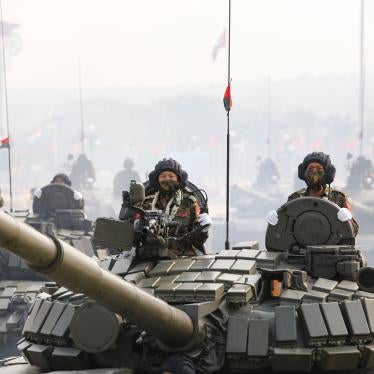In a small Myanmarese army border outpost in Shan State, a sign in English and Myanmarese points into Thailand's thriving tourist town of Doi Ang Khan: "We Are Able." It's probably not much comfort to the soldiers walking around barefoot, enclosed by sharpened bamboo stakes and separated from their comrades by mountains of hostile jungle filled with resentful civilians and vengeful Shan insurgents.
The squalid scene is entirely at odds with the Myanmarese Army's propaganda, the parades mounted on a regular basis to showcase control, progress and development. And it undermines the belligerence shown by the ruling State Peace and Development Council (SPDC).
How strong is the Myanmarese military? One test of strength of an army that didn't hesitate to beat and shoot protesting monks and civilians on the streets of Rangoon can be gauged by its continued recruitment of children into its ranks. This is a sure sign of weakness.
In the past several months, Human Rights Watch has collected testimonies from former child soldiers that show the practice of forcibly recruiting children, some as young as 10, continues freely throughout Myanmar. It is almost impossible to estimate the number of child soldiers currently in the Myanmarese Army, or Tatmadaw, but there are clearly thousands.
Why does the army recruit children? Partly it is because more and more soldiers are needed to enable the army to keep close control over the whole country. Just as with the TNI under Soeharto, the Myanmarese military believes it has an inherent right to rule the country.
But army rule has been a disaster for Myanmar. Deep poverty affects most of the population, unemployment is rampant, corruption is everywhere, and, in the farming communities where most Myanmarese live, ruinous government policies which include using new strains of rice and the forcible planting of bio-fuel crops has increased rural suffering.
Given the deep antipathy most Myanmarese feel towards their reclusive and privileged military leadership, joining the army is not universally appealing. So the army often turns to forcible recruitment of children. Recruitment of the young, the old, and even the infirm, is often coerced and unregulated.
Human Rights Watch has seen internal documents from the ruling council which show that even the senior leadership is cognizant and deeply concerned about deteriorating morale in the ranks, as reflected by increasing desertion rates. All these factors make the recruitment of children less of a concern than keeping manpower rates up.
There are more than 30 non-state armed groups in Myanmar. Some, such as the drug-running United Wa State Army, have more than 20,000 soldiers, many of whom are very young children forcibly recruited. Others, such as the small Karenni Army, with just 1,000 soldiers, have worked hard to reduce their use of children. The lack of a genuine process of national reconciliation explains why many armed groups persist, and the potential for a resumption of large-scale fighting is ever-present.
Many older anti-government insurgents I have interviewed over the years say there were no children in government ranks in the past, and that the Tatmadaw was a professional and battle-hardened force. Not many say that now, as the gap grows between the pampered officer class and the brutalized rank-and-file.
Resentment against the senior generals is widespread in Myanmar, but the fear of challenging them is greater. The authorities punish the family of anyone who questions the military, which is why the often hoped-for split within the army is so elusive. The same soldiers bunkered down in border stockades, many of them children, and in cantonment areas around cities, effectively an army of occupation, are also the victims of the paranoia and intransigence of the SPDC leadership.
The Tatmadaw is also aided by close relations with China, Russia, India and Thailand. For example, in spite of the fact that the military has spent the past 20 years viciously repressing its own people, Myanmar's defense forces have dramatically expanded.
Arms purchases, including weapons systems such as fighter planes, tanks, artillery, naval vessels -- and even a plan to purchase a nuclear reactor -- are facilitated by close allies China, India, and Russia. The Association of South-East Asian Nations has become more frustrated with the SPDC, but its words are not matched by actions.
In the next few weeks, the UN Security Council has the opportunity to censure the SPDC on its use of child soldiers, as Myanmar comes up for review before the Security Council's working group on children and armed conflict. The Security Council has said it will consider targeted sanctions, including arms embargoes, on parties to armed conflict that persist in the recruitment and use of child soldiers. Myanmar's failure is clear: The UN Secretary-General has named the SPDC in four consecutive reports for violating international standards prohibiting the recruitment and use of child soldiers.
Indonesia, which abstained on a Security Council resolution against Myanmar in January, should vote for a strong resolution now and demand an end to the violations against Myanmar's children.
David Scott Mathieson does research on Burma for Human Rights Watch.







